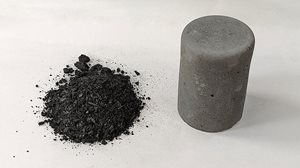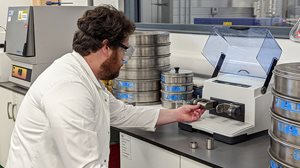Charcoal concrete
A research project in Northern Ireland is exploring how adding recycled carbon – in its purest form – could make better concrete
 Glance in any skip and you will probably see a large quantity of wood waste: everything from plywood and old window frames to chipboard and MDF. It is tricky stuff to recycle or reuse, but a research project in Northern Ireland is looking at how this motley collection of waste items could be put to use – in concrete. “Construction and manufacturing produce a lot of wood waste, but much of it is contaminated with glue, paint or resin,” says Seán McKenna, industrial development associate at the CREST Centre. “Our research was initially focused on how it could be made more reusable.”
Glance in any skip and you will probably see a large quantity of wood waste: everything from plywood and old window frames to chipboard and MDF. It is tricky stuff to recycle or reuse, but a research project in Northern Ireland is looking at how this motley collection of waste items could be put to use – in concrete. “Construction and manufacturing produce a lot of wood waste, but much of it is contaminated with glue, paint or resin,” says Seán McKenna, industrial development associate at the CREST Centre. “Our research was initially focused on how it could be made more reusable.”
McKenna’s team, based at Enniskillen’s South West College, found that turning the waste into charcoal made it a purer, more consistent product. “Charcoal is created by pyrolysis: heating the waste in the absence of oxygen. This drives off a lot of the volatile impurities and leaves us with mainly carbon.” This process is already used in agriculture to make the soil improver, biochar.
 “Unfortunately, our waste wood charcoal is still not pure enough for agricultural purposes. But just as biochar’s unique properties can enhance soil, we believe it could also be a useful additive to concrete.” McKenna is now investigating charcoal’s use as a cement substitute, a hydration controller, and as a volume replacement material. “Of course, using charcoal is a way of storing carbon for the long term and reducing concrete’s carbon footprint. But we are not out simply to maximise carbon sequestration. We want to take an unbiased look at exactly how charcoal can affect concrete in both the curing process and the finished product.
“Unfortunately, our waste wood charcoal is still not pure enough for agricultural purposes. But just as biochar’s unique properties can enhance soil, we believe it could also be a useful additive to concrete.” McKenna is now investigating charcoal’s use as a cement substitute, a hydration controller, and as a volume replacement material. “Of course, using charcoal is a way of storing carbon for the long term and reducing concrete’s carbon footprint. But we are not out simply to maximise carbon sequestration. We want to take an unbiased look at exactly how charcoal can affect concrete in both the curing process and the finished product.
The more we know, the more applications will emerge.” Early research has involved grinding down the charcoal to a fine powder with particles about 50 microns across – a size comparable to cement powder. “As a cement substitute, we are probably looking at just 1 2%,” says McKenna, “but the effects on hydration are interesting. Essentially the charcoal acts as a micro-sponge, initially absorbing moisture and tending to speed up the curing process. This has the potential to deliver buildability benefits on site, or speed up precast production.”
 Counterintuitively, charcoal’s sponge-like properties could also reduce concrete shrinkage: “This usually happens because moisture escapes the concrete too quickly after pouring,” says McKenna. “But we think the charcoal could help by buffering that process. Though charcoal does at first absorb moisture, it seems more water is available for the later stages of curing because it is stored within the charcoal’s high surface area.” Finally, says McKenna, charcoal could make concrete more waterproof: “Carbon is an amazing element. It’s the building block of life and has been called the Lego of the universe. In concrete,
Counterintuitively, charcoal’s sponge-like properties could also reduce concrete shrinkage: “This usually happens because moisture escapes the concrete too quickly after pouring,” says McKenna. “But we think the charcoal could help by buffering that process. Though charcoal does at first absorb moisture, it seems more water is available for the later stages of curing because it is stored within the charcoal’s high surface area.” Finally, says McKenna, charcoal could make concrete more waterproof: “Carbon is an amazing element. It’s the building block of life and has been called the Lego of the universe. In concrete,
we find its shape tends to fill gaps within the microstructure, potentially improving impermeability.” It is an impressive array of qualities for a material derived essentially from dirty wood, and McKenna, who is also an architect, is keen to develop the research further in conjunction with a producer or manufacturer.
Interview by Tony Whitehead
Published in CQ Autumn 2022